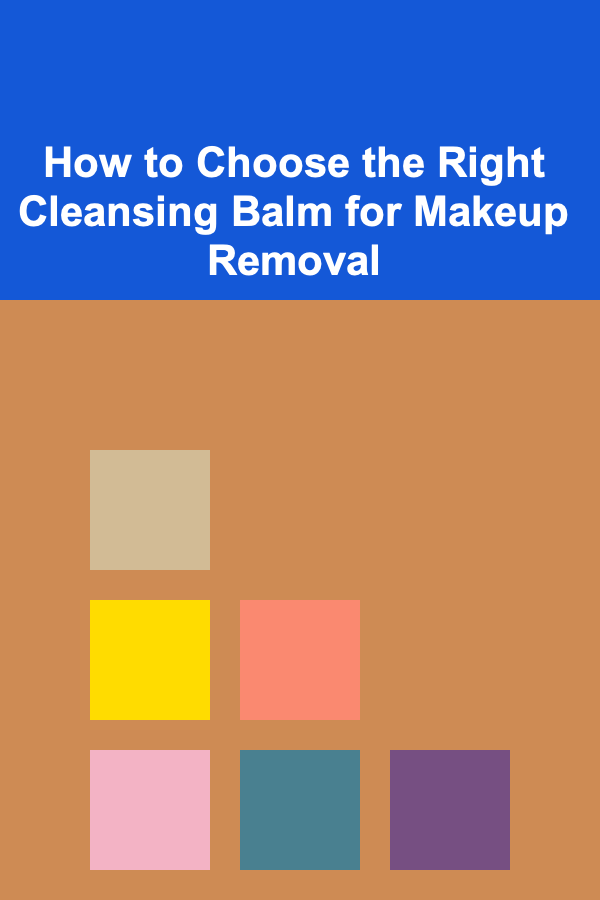
How to Choose the Right Cleansing Balm for Makeup Removal
ebook include PDF & Audio bundle (Micro Guide)
$12.99$8.99
Limited Time Offer! Order within the next:

Makeup removal is an essential part of any skincare routine. It not only helps to clean the skin but also ensures that makeup, dirt, and environmental pollutants don't clog pores or cause breakouts. Among the many makeup removal products available, cleansing balms have become increasingly popular due to their effectiveness and gentle nature. These balms are rich, luxurious, and designed to dissolve makeup, even the most stubborn waterproof formulas, while nourishing and hydrating the skin.
However, with a wide variety of cleansing balms on the market, choosing the right one for your skin type and concerns can be a daunting task. This article will guide you through the process of selecting the perfect cleansing balm for makeup removal, helping you make an informed decision based on your skin's needs.
What is a Cleansing Balm?
A cleansing balm is a solidified oil product that transforms into a rich oil-like texture when massaged into the skin. It is primarily designed for makeup removal, cleansing, and sometimes even as a first step in a double-cleansing routine. When you apply the balm to your dry face, it melts effortlessly, breaking down makeup, oils, and impurities, and it can be wiped away with a damp cloth or rinsed off with water.
What makes cleansing balms unique is their ability to deeply cleanse while maintaining the skin's natural moisture. Unlike traditional cleansers that may strip the skin, balms typically contain nourishing ingredients that hydrate and replenish the skin after makeup removal.
Why Choose a Cleansing Balm?
Before diving into how to choose the right cleansing balm, it's essential to understand why you should consider using one.
1. Effective Makeup Removal
Cleansing balms are incredibly effective at breaking down makeup, including long-wear and waterproof formulas. They are ideal for people who wear heavy makeup, as they dissolve stubborn layers without the need for excessive scrubbing or harsh chemicals.
2. Gentle on the Skin
Unlike some other makeup removers, cleansing balms are generally very gentle. They work well on sensitive skin and are less likely to cause irritation or dryness. Most balms are formulated with nourishing oils that leave the skin feeling hydrated, smooth, and soft after use.
3. Versatility
Cleansing balms can be used on all skin types and are especially beneficial for dry or mature skin. They also serve as a first step in double-cleansing, a skincare method that uses an oil-based product followed by a water-based cleanser for a deeper clean.
4. Convenience
The balm's solid texture makes it easy to store and travel with. It doesn't spill, and you don't have to worry about leaks, which makes it a great option for on-the-go makeup removal.
How to Choose the Right Cleansing Balm for Your Skin
Selecting the right cleansing balm requires understanding your skin's needs and choosing a balm that aligns with those needs. Several factors should be taken into consideration, including your skin type, any sensitivities or allergies, and your specific concerns.
1. Consider Your Skin Type
Different skin types require different formulations. Some cleansing balms are better suited for dry skin, while others are formulated for oily or acne-prone skin. Here's a breakdown of how to choose based on your skin type:
For Dry Skin
If you have dry or dehydrated skin, look for cleansing balms that are rich in hydrating and moisturizing ingredients. Balms with ingredients like shea butter, avocado oil, or coconut oil are ideal for adding moisture back into the skin while cleansing. These ingredients will help replenish the skin's natural oils, leaving it soft, supple, and nourished. Avoid balms with strong astringents or drying agents, which may strip your skin of its natural moisture.
For Oily Skin
Those with oily skin can also benefit from cleansing balms, but it's important to look for formulations that are lighter in texture and non-comedogenic. Look for balms with oils like grapeseed oil or sunflower oil, which are lightweight and won't clog pores. Balms that contain tea tree oil or other anti-inflammatory ingredients can help regulate excess oil and prevent breakouts.
For Sensitive Skin
If you have sensitive skin, it's essential to choose a balm with calming ingredients such as chamomile, calendula, or aloe vera. These ingredients help soothe inflammation and redness, while also providing a gentle cleanse. Opt for fragrance-free or hypoallergenic balms to minimize the risk of irritation.
For Combination Skin
Combination skin requires a more balanced approach. Look for cleansing balms that offer hydration without being too greasy or heavy. A balm with a balanced formula containing a mix of nourishing oils and light cleansing agents is a good option for combination skin.
2. Check for Added Benefits
Some cleansing balms come with added skincare benefits that go beyond just makeup removal. These include:
Anti-Aging Properties
If you're looking for a balm that offers anti-aging benefits, look for formulas that contain ingredients like retinol, peptides, or antioxidants. These ingredients can help stimulate collagen production, reduce the appearance of fine lines and wrinkles, and protect the skin from free radical damage.
Exfoliating Ingredients
Some cleansing balms contain mild exfoliating ingredients, like fruit enzymes or gentle acids, that can help slough off dead skin cells and promote skin renewal. These are ideal if you're looking to improve the texture of your skin or address concerns like dullness or uneven skin tone. However, if you have sensitive or reactive skin, avoid balms with exfoliating agents, as they may cause irritation.
Hydrating Ingredients
Look for ingredients such as hyaluronic acid or glycerin, which are known for their hydrating properties. These ingredients help to retain moisture in the skin and prevent the balm from leaving a dry, tight feeling after use.
3. Fragrance and Sensitivity
Fragrance in skincare products can be a trigger for irritation, especially for those with sensitive skin. When choosing a cleansing balm, pay attention to whether it contains added fragrances or essential oils, particularly if you have sensitive or allergy-prone skin. A fragrance-free balm is always a safe option to avoid any risk of allergic reactions or skin sensitivity.
4. Ingredients to Avoid
Certain ingredients can cause skin issues, so it's essential to read the label and avoid these when selecting a balm:
- Parabens: Preservatives that can irritate the skin or disrupt hormones.
- Sulfates: Harsh cleansing agents that can strip the skin's natural oils.
- Alcohol: Can dry out and irritate the skin, especially in sensitive areas.
- Artificial Colors and Fragrances: These can cause allergic reactions, especially for sensitive skin.
5. Look for Non-Comedogenic Formulas
If you have acne-prone skin, choose a balm that is labeled "non-comedogenic," meaning it won't clog your pores. Oils such as jojoba oil, grapeseed oil, and argan oil are typically safe for acne-prone skin, as they are light and less likely to contribute to breakouts.
6. Sustainability and Packaging
With growing awareness about the environmental impact of plastic, many brands are focusing on sustainable packaging. If sustainability is important to you, consider choosing a balm from a brand that uses eco-friendly packaging, such as recyclable or biodegradable containers.
How to Use a Cleansing Balm
Once you've selected the right cleansing balm for your skin, it's important to know how to use it effectively:
- Scoop a small amount of the balm with clean fingers or a spatula.
- Massage the balm onto dry skin with gentle circular motions. The balm will melt and break down makeup, sunscreen, and impurities.
- Add warm water and continue to massage, turning the balm into a milky texture.
- Rinse thoroughly with warm water or use a damp cloth to wipe off the product.
- Follow up with a second cleanse if you practice double cleansing.
Conclusion
Choosing the right cleansing balm for makeup removal comes down to understanding your skin's needs, reading product labels carefully, and looking for the right ingredients. A good cleansing balm should cleanse without drying, leave your skin feeling nourished, and effectively remove makeup. By considering factors like your skin type, any sensitivities you may have, and additional skincare benefits, you'll be able to select a cleansing balm that fits seamlessly into your routine.
Remember that skincare is personal, and finding the right product may take a little trial and error. However, once you discover the perfect balm, you'll appreciate the smooth, hydrated, and clean skin it leaves behind. Happy cleansing!

How to Add a Pop of Color to Your Holiday Decorations
Read More
How to Create a Pet-Friendly Organized Space
Read More
How to Make a Checklist for Writing an Effective Job Description
Read More
How to Store Fertilizers and Soil Amendments Properly
Read More
How To Master Clicker Training for Cats
Read More
10 Tips for Effective Defect Reporting
Read MoreOther Products

How to Add a Pop of Color to Your Holiday Decorations
Read More
How to Create a Pet-Friendly Organized Space
Read More
How to Make a Checklist for Writing an Effective Job Description
Read More
How to Store Fertilizers and Soil Amendments Properly
Read More
How To Master Clicker Training for Cats
Read More